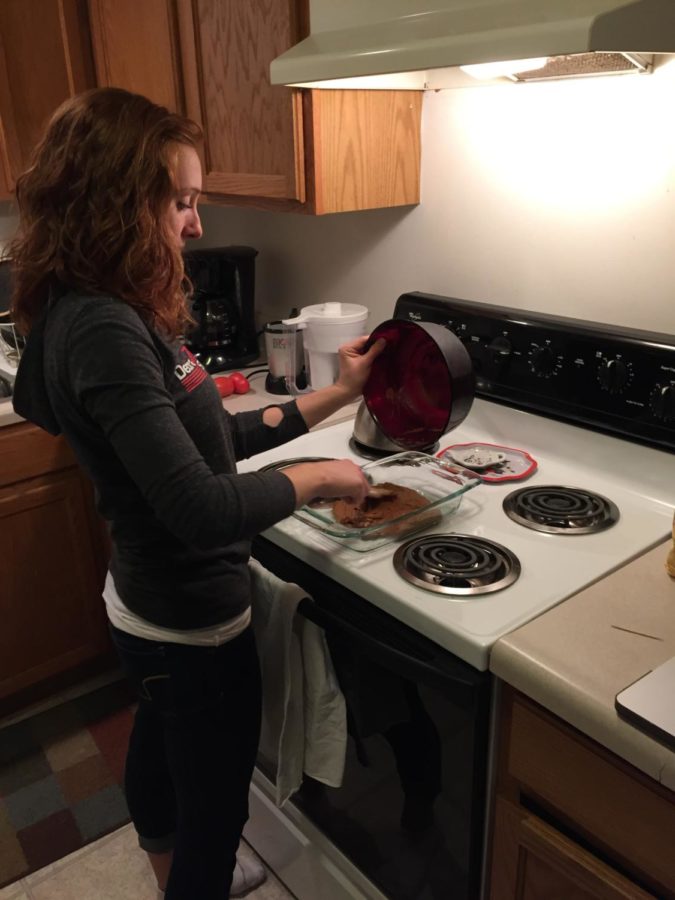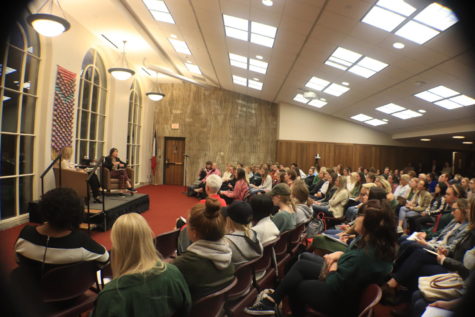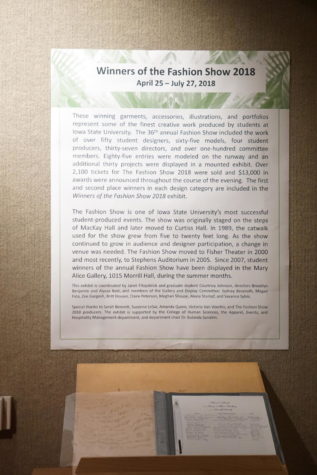ISU student adopts veganism for week to explain lifestyle’s popularity
November 5, 2015
Think back to the last thing you ate. Do you know where it was grown? Or what impact its production had on the environment?
Veganism, an alternative lifestyle that excludes the use or consumption of animal byproducts, urges people to consider questions like these when making food and lifestyle decisions.
In order to learn about what it’s like to be a vegan on Iowa State’s campus, I decided to adopt the vegan lifestyle for a week to experience eating and living meat and dairy free. By becoming a vegan, and talking to other vegans on campus, I learned how and why individuals choose this lifestyle.
One vegan student on campus said something during an interview that fully encompassed my interest in taking on this challenge. Eating is one of my passions, but rarely do I take time to think about the food I consume.
“Be aware that when you eat something it does have an effect,” said Caitlin Flux, junior in human sciences. “Everything you put on your plate has a history, and it does impact the future. It does have environmental consequences. It does contribute to world hunger. It does contribute to global warming, and it does contribute to the suffering of other sentient beings. [Food] has a footprint.”
The concept of being aware of the footprint of food is a major factor in the increase in popularity of veganism within the last few years.
Veganism is defined by the Vegan Society as “a way of living which seeks to exclude, as far as is possible and practicable, all forms of exploitation of and cruelty to animals for food, clothing or any other purpose.”
Individuals who choose to live the vegan lifestyle consume primarily a plant-based diet.They exclude all animal-related products from their regimen including meat, dairy, eggs and honey.
Along with choosing to exclude animal products from their diets, many vegans also choose to avoid makeup and other products that are tested on animals and those that are made of animal products, such as leather.
This message was on repeat in my mind as I embraced the adventure of becoming vegan for a week.
Although veganism is growing in popularity, it can still be a difficult lifestyle for some regarding food availability and the lack of support from others. Being a vegan student on Iowa State’s campus is possible and rewarding for those who are passionate about the lifestyle, but it does presents challenges.
As a self-proclaimed burger enthusiast and lover of all things dairy, veganism has never previously crossed my mind as a viable lifestyle choice. I agree with many of the moral aspects of the lifestyle, but I was never willing to give up the dairy and meat products I love.
After a week of embracing veganism, I can say with certainty that I learned a shocking amount of information about the footprint of food, and I was surprised at the physical differences I felt in my body even within just one week.
I had more energy and generally felt more healthy because of the decrease in my consumption of sugar and oils. The benefits of the lifestyle became apparent immediately, as did the challenges.
As I began my vegan journey, I decided my main motivation to stick to the lifestyle would be to investigate why people choose to be vegan.
Vegan principles attract individuals for a variety of reasons; the most prevalent reasons are to support animal welfare, to improve health, to increase the welfare of others and to benefit the environment, according to the Vegan Society.
“[I initially chose veganism] for animal welfare and animal rights … the ethical side of it,” Flux said. “Then, once I stopped eating meat, dairy and animal products in general, I started to meet people and talk about it more and learned about the environmental side and health benefits as well.”
Apple Amos, sophomore in biology and vegan of four years, had a similar experience with increased passion for the lifestyle over time.
“Initially I chose veganism for ethical reasons, animal cruelty and animal agriculture, but the longer I’ve been in it the more reasons I’ve acquired,” Amos said. “A big part of it now is workers’ rights. Everyone thinks of migrant workers in the vegetable fields, but it is ten times worse in slaughter houses.”
By avoiding animal products, vegans can potentially experience a variety of health benefits such as lower blood pressure and cholesterol, a lower risk for cardiovascular disease and diabetes, a lower average body mass index and a lower risk of obtaining certain cancers, according to Appetite, an international research journal focusing on behavioral sciences especially food and beverage intake.
Veganism may also help reduce harmful environmental effects caused by the meat and dairy industries, according to the Johns Hopkins Bloomberg School of Public Health.
These effects include the contamination of water sources by animal waste, the inefficient use of water for growing crops for animal feed and the wasteful use of land to grow food for animals instead of people, according to the school.
On-campus resources are available for students who are vegan.
One of these resources is meatless and dairy-free meal options provided in the campus dining centers.
Another resource is the availability of a dietitian who can meet with students who have a meal plan and help outline nutrition and meal guidelines.
Lisa Nolting, dietitian with ISU Dining, said the dining center has seen a large increase in students requesting vegan and vegetarian diets over the past few years.
The dining management team, chefs and a group of student informants work together to utilize student feedback and create menus that provide food for students with various diet restrictions, she said.
Students can utilize Net Nutrition, a resource on the ISU Dining website that lists entrées of the day, and the ingredients in them, to see what meal options are available.
Simple Plate, a venue in the Union Drive dining center offers a vegan option every day, an example of one of the meatless and dairy-free options provided for students.
Though ISU Dining offers some vegan meals, students have expressed frustration regarding the options.
During a meeting held by the Ethical Eating Club, a club on campus that focuses on educating students on veganism, vegans agreed that the hardest part of being vegan on campus was the lack of food options. The club has made it one of their goals to work with dining center management to see an increase in vegan options in the near future.
Most of the students instead prefer to cook at home when possible, which, along with eating at restaurants off campus, presents much easier eating options for vegan students.
Vegan ingredients can be found at all the grocery stores in Ames, with Aldi’s and Wheatsfield Co-op being favorites among students. Restaurants in Ames that offer vegan options include Downtown Deli, Fighting Burrito, The Pita Pit, The Spice, Vesuvius and more.
As a student living off-campus, I do not have a meal plan. I did not personally experience being vegan in the dining centers during the week, but I instead made it a goal to grocery shop and cook as many vegan meals as possible. I cooked at least one new meal a day and relied heavily on meal planning for the rest of my meals. I am also a huge fan of snacking throughout the day, so I made sure to have plenty of vegan snack options, such as almonds and pretzels, available.
My grocery trip for the week was about $30 more expensive than my normal grocery bill, but that is solely because I went shopping while hungry, which is always detrimental to a bank account, and I purchased more luxurious, unnecessary vegan ingredients. If I had stuck with just my meal essentials, my grocery bill would have been comparable to my normal weekly grocery expenses.
I am adventurous with food; I eagerly, yet slightly apprehensively, placed veggie sausage in my cart during one grocery run, which, after being smothered with maple syrup, was surprisingly very similar to regular sausage, along with other items like black beans, quinoa, veggies, hummus and soy milk. Tofu was the only ingredient that threw me off a bit — I loved the others and am now thoroughly obsessed with both black beans and hummus.
My favorite vegan meals included vegan pancakes made with coconut flour, kale smoothies, quinoa dishes with a variety of veggies and black bean tacos. Not once did I feel hungry due to the lack of meat and dairy in my new diet.
It took a while for my body to get used to the absence of those foods, but I was surprised with the physical benefits I felt. After consuming a vegan meal, I often felt full for longer and did not experience the uncomfortable, bloated feeling sometimes present after a large, meat-heavy meal.
As a huge fan of meal planning, I was amazed at the versatility of many of the ingredients I used. I made a large batch of quinoa at the beginning of the week, and I mixed in different ingredients for different meals, such as black beans for supper and cinnamon and apple for breakfast. Using this method, my meals were actually quicker to prepare than my non-vegan meals.
While I did not experience the difficulty of finding food on campus, I did experience the difficulty of others not understanding the lifestyle choice, which was the other main hardship of being vegan expressed by the vegan members of the Ethical Eating Club.
Often the responses I received when telling people about the lifestyle were along the lines of, “Why would you do that? I feel so bad for you.”
The negative responses made it very clear that many people are not aware of the reasons people choose a vegan lifestyle. The members of the Ethical Eating Club expressed that by meeting other people who share the same values, vegan students can create a network of people with similar beliefs, which makes the lifestyle easier.
The members also talked about the two main types of vegans: those who view it as a diet and those who view it as a lifestyle. They explained that the people who exclude meat and dairy simply to follow a diet often times give in and revert back to meat and dairy. Those who view it as a true lifestyle change, however, are much more likely to view the restriction of meat and dairy as less of a sacrifice and more of a beneficial change both for themselves and others.
Although there were certain aspects of my diet I missed, such as cheese and ice cream, going vegan was not as hard as I thought. I will definitely be incorporating more vegan meals in my diet from now on.
A friend of mine agreed to follow the lifestyle with me for the week, which helped immensely. When I almost caved and bought a donut on central campus, she was there to talk me out of it. And when I was craving a dairy-filled meal, she would spam my Pinterest with amazing looking vegan meals to try. I would advise anyone thinking about transitioning to veganism to reach out to others to make connections and receive support through the lifestyle change.
“Go easy on yourself. Know that with anything you want to change about yourself [is] long-term; you can’t just go cold turkey and expect there to be no failures. If you go easy on yourself and give yourself a little bit of leeway, you will find it a bit easier,” Flux said.

















